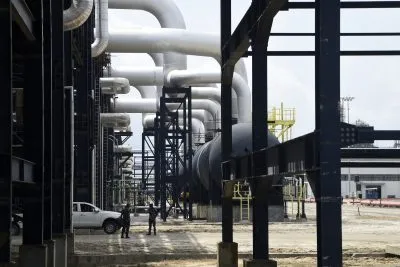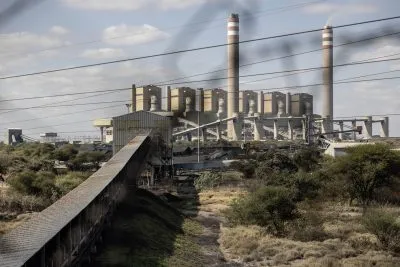Vuyo Ntoi, a 45-year-old Oxford-educated South African and Co-Managing Director of African Infrastructure Investment Managers (AIIM), is an expert on private equity investment in infrastructure, clean energy, transport and digitisation.
He was a mere 18-year-old when Nelson Mandela became South Africa’s first president of the democratic era in 1994. Madiba recognised that infrastructure finance cannot be met by only governments, banks and multilaterals; private sector investment and partnerships also had a vital role to play.
AIIM, a subsidiary of Old Mutual Alternative Investments (OMAI), a member of the global Old Mutual Group, was inspired by this ambition. In 21 years, it has built a $2bn-plus investment portfolio across South, West and East Africa.
Ntoi, who has been at the forefront of this development, spoke to our correspondant Mushtak Parker.
Would a pan-African set of regulations for private equity investments mitigate transnational issues?
I don’t think continent-wide regulations are a realistic solution. We continue to encourage countries not to reinvent the wheel and to focus on developing regulatory environments that have been successful in other markets. We have seen the harmonisation of transnational issues on the TRAC N4 toll road project between South Africa and Mozambique, where the regulations were harmonised between them, and risk allocation was optimal.
If you hand projects to the private sector with the right incentives and oversight, it is well placed to deliver. That is what has happened to Independent Power Producers (IPPs) to date.
African infrastructure, it is oft said, has a deficit of $100bn currently. If you look at the total stock of African pension funds it is circa $400bn – just one year’s need from an infrastructure spend is one quarter of the total pension stock. Of the $100bn infrastructure investment required, more than half will have to come from abroad.
How important is a credible risk mitigation and credit enhancement strategy to make projects ‘bankable’ for promoters and their bankers?
There are typical Triple ‘A’ risk guarantees behind governments and their obligations, either through MIGA, the political risk insurance agency of the World Bank, or other export credit agencies (ECAs). These projects still give incremental returns that are commensurate with the risk in the country.
We are a risk mitigator to entry to markets. The projects we invest in have contracted cash flows. The entity takes earnings from its revenues.
The responses around Covid-19 – reduced interest rates, discounting and increased valuation of assets while the revenue remained constant – saw our infrastructure portfolios perform well because of the low-risk.
Is co-financing with development financial institutions (DFIs) an important fit for AIIM?
We have good relations with MIGA and the Islamic Development Bank (IsDB) and its entities, with whom we have cooperated in projects in West Africa. Confidentiality rules prevent us from disclosing the projects. We see good potential in using Islamic finance to support African projects. This could unleash significant amounts of capital from the Middle East.
DFIs are a key supporter of increased renewables and a big funder of infrastructure projects in Africa. They have helped unlock long-term capital through tenor extension for debt and as credit enhancement tools. They remain a key partner of private equity in Africa through investment in private funds and the provision of long-term debt capital.
What is your investment strategy going forward?
Our strategy comprises dollar funding into Sub-Saharan African (SSA) projects, excluding South Africa and investing South African pension funds into local, national and SADC project opportunities.
Recent investments include a large stake in Sodigaz, an LPG distributor in Burkina Faso and Benin, through our pan-African infrastructure fund, AIIF3. We increased our stake in MetroFibre Networx in South Africa; and acquired Onix Accra 1, the only Tier IV data centre in Ghana.
We have a three-pronged approach to investing – digital infrastructure, energy transition and physical infrastructure. Our priorities beyond 2021 centre around changing demographics in Africa. People are moving into cities at an increasing pace, which means certain utilities and services need to be provided on a sustainable basis.
Another priority is to be a key digital enabler for living in large metropolitan areas. This means the provision of infrastructure – data centres, fibre networks, and towers for cell phones.
We are also looking to participate in logistics corridors through investment in ports, storage and handling facilities and linkages between ports and terminals that are the arteries of trade. AIIM is one of the largest investors in the private road programme in South Africa.
AIIM is a major investor in renewable energy. Are governments doing enough to transition to a low-carbon environment as part of their commitment to the Paris Climate Agreement?
We are the largest investor in the Renewable Programme in South Africa, which makes us one of the largest renewable investors on the continent. South Africa enjoys some of the lowest renewable energy prices in the world, as low as 50 cents ($0.034) per kWh, I believe.
Renewables are an important component of the government’s Integrated Resource Plan. A more proactive roll-out of renewable energy projects is needed. The total new power capacity required is 33,364MW up till 2030. Of that, wind power will account for 17,000MW and Photo Voltaic (PV) 8,000MW.
This means that 25,000MW of the 33,000MW are renewables. Of the new generation capacity, IPPs could provide more power.
Under Pretoria’s Renewable Energy Independent Power Producer Programme (REIPPP), we see a short-term total pipeline of projects of circa 2.5GW in the commercial and industrial space.
Elsewhere, we are pioneering IPPs through the Lekki Concession Company. We have invested in the Cenpower IPP power project, Tema Ghana and Albatros Energy Mali power station, the first IPP in Mali.
We also participate in the South African Renewable Energy for Rural Access Project Programme. Our message is for the government to have projects as part of a broader national development plan and to come up with a process that is based on an international tender with best practices that becomes a repeatable process.
IPPs and public sector generation may account for a 4% contribution to GDP. This is significant and bodes well for renewables and IPP growth.
South Africa is the highest CO2 emitter in Africa, and among the top 20 globally, partly due to its reliance on coal and oil. How can this be changed?
We support reducing the impact of climate change. We don’t invest in coal or the coal value chain. We have developed a framework to ensure that whatever investments we might make into the gas sector for instance are supportive of meeting the Paris goals. If the country is displacing coal and using gas as the base for bringing in more renewables onto the grid, then we will support that. We appreciate the impetus to net zero by 2050 is a big theme internationally, although it could be a problem for many African carbon resource-heavy nations.
The failure to move towards clean energy has a cost impact, as renewable energy is cheaper. There is the risk that our large trade partners introduce carbon tariffs, which penalise products that are made using carbon-intensive energy.
Do you have an offtake agreement with the beleaguered South African energy utility, Eskom?
Eskom has not missed a payment to IPPs. The obligations of Eskom under those Power Purchases Agreements are guaranteed by the South African government. True, its balance sheet is currently under strain but operationally, Eskom remains cash-rich, with R108bn ($7.4bn) revenues in 2020, and does not suffer from liquidity problems.
Eskom will eventually get its balance sheet sorted. It is also restructuring into its constituent parts to ensure more transparency and better risk management. Eskom and IPPs will succeed in delivering electricity including renewables, which currently require R200bn in investment to deliver 3,000MW of electricity.
Should South Africa’s President Cyril Ramaphosa open up the energy sector to more IPPs? Should he have gone further when he allowed IPPs to generate 100MW of electricity under the amended Energy Regulation Act?
It’s not a cap on IPPs – it’s a cap on IPPs requiring licences, which is a bureaucratic process. We were calling on the government to increase the capacity to 10MW. As load shedding increased over the past year or so, we called for the cap to increase to 50MW or to 100MW. Going for the full 100MW was quite a bold move from the President.
As can be seen from the load shedding and outages, Eskom’s balance sheet almost precludes it from procuring additional new generation. The private sector can take on the capital risk and sell the electricity to Eskom.
Want to continue reading? Subscribe today.
You've read all your free articles for this month! Subscribe now to enjoy full access to our content.
Digital Monthly
£8.00 / month
Receive full unlimited access to our articles, opinions, podcasts and more.
Digital Yearly
£70.00 / year
Our best value offer - save £26 and gain access to all of our digital content for an entire year!
 Sign in with Google
Sign in with Google 



